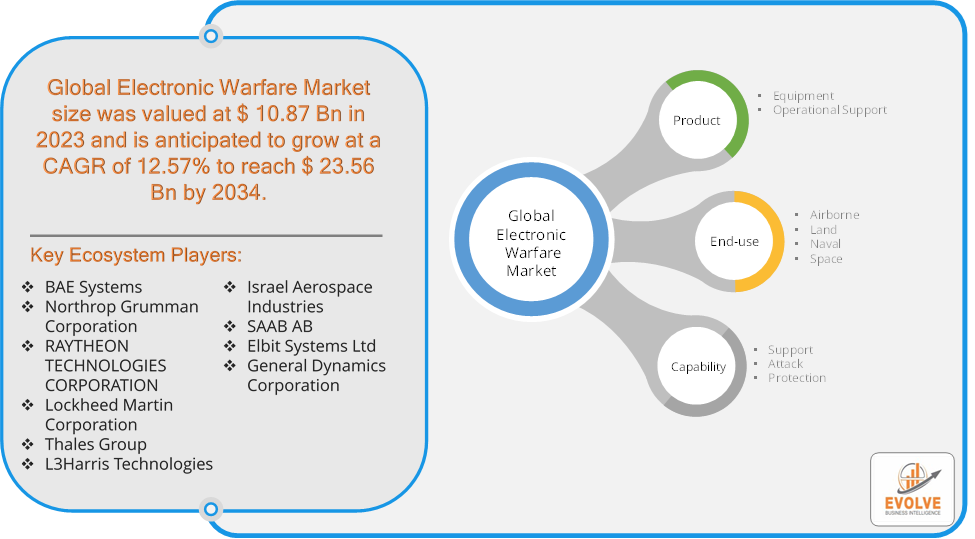Blog
Electronic Warfare Market Surges: 12.57% CAGR

Evolve Business Intelligence has published a research report on the Global Electronic Warfare Market, 2021–2034. The global Electronic Warfare market is projected to exhibit a CAGR of around 12.57%during the forecast period of 2021 to 2034.
Evolve Business Intelligence has recognized the following companies as the key players in the global Electronic Warfare Market: BAE Systems, Northrop Grumman Corporation, RAYTHEON TECHNOLOGIES CORPORATION, Lockheed Martin Corporation, Thales Group, L3Harris Technologies, Israel Aerospace Industries, SAAB AB, Elbit Systems Ltd, General Dynamics Corporation.
 More Information: https://evolvebi.com/report/electronic-warfare-market-analysis/
More Information: https://evolvebi.com/report/electronic-warfare-market-analysis/
Market Highlights
The Electronic Warfare Market size accounted for USD 10.87 Billion in 2023 and is estimated to account for 12.52 Billion in 2024. The Market is expected to reach USD 23.56 Billion by 2034 growing at a compound annual growth rate (CAGR) of 12.57% from 2024 to 2034. The Electronic Warfare (EW) Market involves the use of electromagnetic spectrum to detect, disrupt, or manipulate enemy communications, radar, and other electronic signals. It encompasses technologies like jamming, electronic countermeasures, and intelligence gathering. EW is vital for military operations, enhancing both defensive and offensive capabilities by protecting assets from adversary attacks while compromising their systems. The market is driven by increasing geopolitical tensions, modernization of military equipment, and advancements in cyber and electromagnetic technologies. Applications include air, naval, ground, and space-based platforms used by defense forces globally.
Segmental Analysis
The global Electronic Warfare market has been segmented based on Product, End-use, Capability
Based on the Product, the market is segmented based on Equipment, Operational Support. the Equipment segment dominates. This is due to the essential role of physical EW systems, such as radar jammers and electronic countermeasure devices, in both defensive and offensive operations.
Based on the End-use, the market has been divided into Airborne, Land, Naval, Space. the Airborne segment dominates. This is driven by the extensive use of EW systems in aircraft for both offensive and defensive operations, as well as their critical role in air superiority and surveillance missions
Based on Capability, the market has been divided into Support, Attack, Protection. the Protection segment dominates. This is due to the high demand for EW systems designed to safeguard military assets and communication networks from electronic attacks and interference
More Information: https://evolvebi.com/report/electronic-warfare-market-analysis/
Regional Analysis
The Electronic Warfare market is divided into five regions: North America, Europe, Asia-Pacific, South America, and the Middle East, &Africa. North America dominates the Electronic Warfare market due to several factors. In 2022, the North American Electronic Warfare Market was valued at USD 7.099 billion, and it is anticipated to increase at a substantial compound annual growth rate (CAGR) throughout the course of the research. The Department of Defense’s largest defense spending in the United States is to blame for the surge. The United States of America allocated USD 782 billion for defense in 2022. The government allocated USD 3.17 billion by 2021 to the U.S. 45 Electronic Warfare programs across military service divisions and other platforms. The Asia-Pacific region has been witnessing remarkable growth in recent years. From 2022 to 2030, the Asia-Pacific Electronic Warfare Market is anticipated to expand at the fastest rate. The expansion of the region is attributed to rising defense spending from countries like Australia, China, Japan, and India. The Indian Air Force plans to equip its fleet of fighter aircraft with an advanced Electronic Warfare suite. The Indian defense ministry entered into an agreement with Bharat Electronics Limited (BEL) to supply the Indian Air Force with state-of-the-art fighter aircraft equipped with these features.


